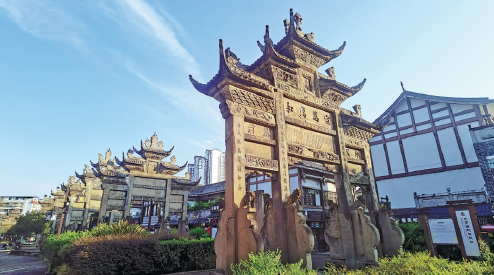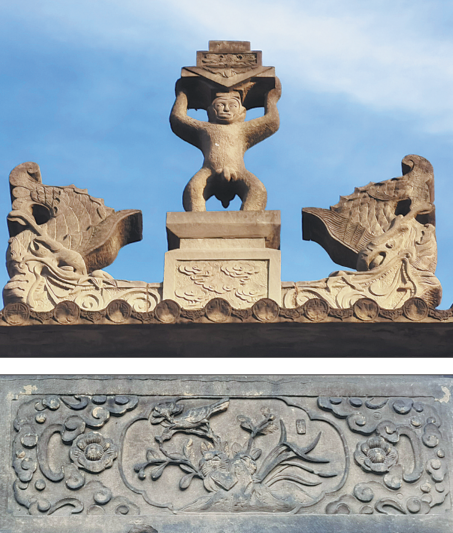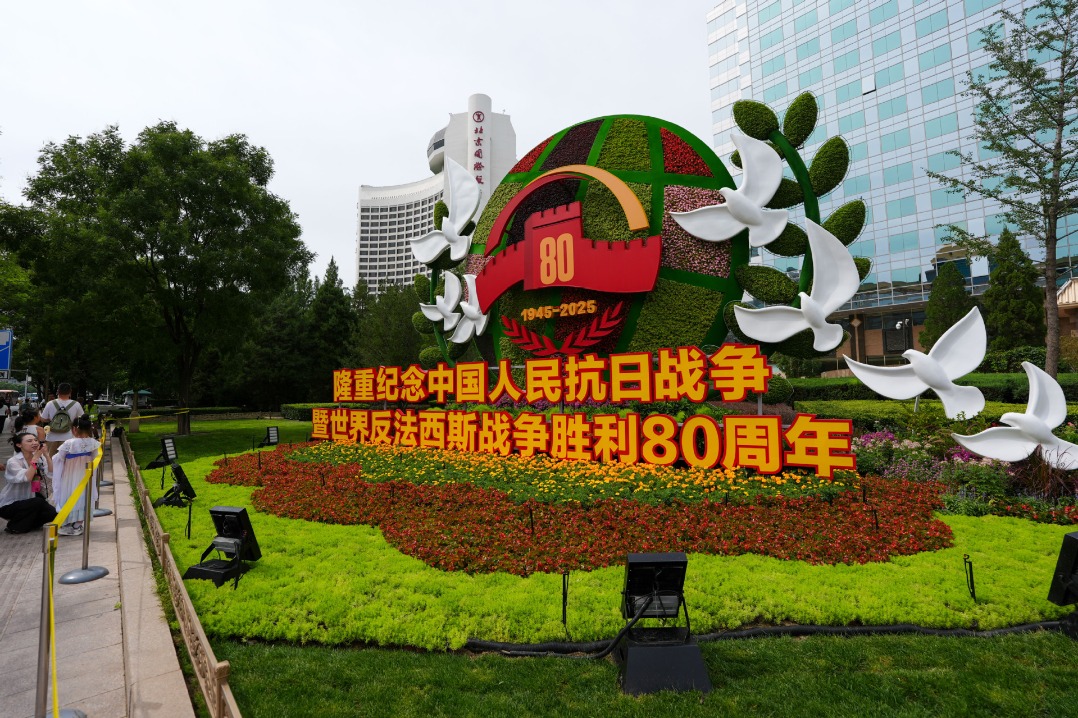Down memorial lane
Ancient Sichuan post road, punctuated by unique commemorative archways, is a popular tourism destination, Huang Zhiling and Ning Guangxia report in Chengdu.

In these modern times, many of the world's ancient post roads have long since been paved over, replaced and built on. However, for the residents of Longchang, a city under the administration of Neijiang in Sichuan province, one such road is the center of daily life.
Early in the morning, people exercise on the 1,700-year-old post road which runs through the center of the city. Others traverse its bluestones on their way to buy breakfast, or meat and vegetables for lunch and supper. In the evening, they stroll leisurely along it to burn off the calories of those sumptuous meals.
Standing along the road are a group of seven bluestone memorial archways built during the Qing Dynasty (1644-1911) to honor local officials who worked for the public good, people showing filial piety, chaste widows taking good care of their parents-in-law and bringing up their children, a generous person helping the needy and a centenarian.
Longchang abounds in the material and is known as China's hometown of bluestone. It used to have 69 bluestone memorial archways. Now, just 17 built between 1496 in the Ming Dynasty (1368-1644) and 1887 exist. Seven are on the southern part of the post road in the city center, six are on the northern part of the road near the Longchang No 2 High School and the remaining four are scattered across the city's various towns.
The archways promoting virtues among officials and filial piety among the people are like public service posters on today's expressways, says Zhang Dechao, head of Neijiang's municipal bureau of culture, radio, television and tourism.
Longchang, located between Chengdu, capital of Sichuan, and neighboring Chongqing, has been an important cargo distribution and passenger transport center since ancient times.
The post road in Longchang led to Zigong in Sichuan to the north, Yunnan province to the south, Chengdu to the west and Hubei and Hunan provinces to the east.
"The archways were intended to promote virtue and filial piety to people who left or entered Longchang along the road," Zhang says.
The first archway on the southern part of the post road is the Archway of Virtue for Giorro Guohuan. Built in 1871 by gentry, seniors and common people in Longchang, then a county, it honors Giorro Guohuan who is known for reducing the taxes of locals after droughts and providing funds for local schools from his own wages.
The archway is unique because it has a double-faced male monkey standing on the top, holding an official seal. It is commonly known as the Monkey Memorial Archway.
The design displays the hope of locals that Giorro Guohuan would be quickly promoted to the rank of feudal lord, as the words for "monkey" and "standing" in Chinese have a similar pronunciation as "feudal lord" and "immediately".
The Memorial Archway for Suqing's Benevolent Rule was built in 1856 on the northern part of the post road to honor Nala Suqing, who was from an ethnic Manchu family and served as a county magistrate in Longchang from 1855 to 1860.
In the first year when Nala Suqing served as the county magistrate, Longchang endured a drought and the seedlings of cereal crops were ruined. The cost of rice rose sharply to the dismay of the people.
Nala Suqing spurred the people of the county to dig wells from which they could irrigate their crops in the face of the drought. He cracked down upon dishonest merchants to cap rice prices and took it upon himself, at the risk of his own life, to open the official barn without the prior agreement of the higher authorities and distribute cereals to common people.
Later, while leading soldiers to fight against rebels, Nala Suqing was stabbed 37 times and died from his wounds. As he was poor and had fewer than 100 grams of silver, Longchang people raised funds to send his coffin to his hometown in Changbaishan, Jilin province.
It was the common practice that one archway honored one person. However, the General Memorial Archway for Chastity and Filial Piety on the southern part of the post road, built in 1855, is a commemoration of 188 women honored by the Qing court.
The Memorial Archway for Guo Yulan's Good Deeds and Merits was built in 1887 on the southern part of the post road after Emperor Guangxu of the Qing Dynasty issued an imperial edict to honor Guo, a native of Longchang, who had undertaken good and charitable deeds all his life.
During the Qing Dynasty, a person reaching 100 years of age was rare, and the Memorial Archway for Shu Chengshi, who achieved that milestone, was built on the southern part of the post road in 1880.
It is the only archway for a centenarian among China's archways under national-level protection. The words "being rare in this earthly life", by Sichuan governor Ding Baozhen, and "a peaceful nation giving people the auspicious sign of longevity", by Longchang county magistrate Yang Zhun, are inscribed on the archway.
According to Chen Juqiang, former director of Longchang's cultural relics administrative office, Shu passed away at 103.
Under an hour's drive away is Neijiang, where the memorials of the city's two cultural celebrities Zhang Daqian (1899-1983) and Fan Changjiang (1909-1970), are located.
Zhang was one of the most influential painters and calligraphers of the 20th century. Photos of Zhang meeting Pablo Picasso at the Spanish artist's home in Nice, France, in 1956 can be found at Zhang's memorial.
Picasso and Zhang admired each other. During their meeting, Picasso gave Zhang 600 artworks, all of which were his imitations of Chinese paintings, and asked Zhang to teach him how to draw bamboo, says Li Junxi, a guide in Zhang's memorial.
Fan was the first reporter in China to faithfully report on the Red Army's Long March.
From October 1934 to October 1936, the Red Army soldiers marched through raging rivers, cold mountains and desolate grasslands to break the siege of Kuomintang forces.
In 1935, Fan, 26, spent 10 months interviewing and delivering reports from the Long March to people across China. His reports were published at least one year earlier than the accounts in Red Star Over China by American journalist Edgar Snow.
China established the Fan Changjiang Journalism Award to honor outstanding Chinese journalists in 1991. The award later became the Changjiang Taofen Award, after Fan and another renowned journalist, Zou Taofen (1895-1944).
The Changjiang Taofen Award and the China Journalism Award are the two most prestigious journalism prizes in China.
"In a certain sense Fan is still alive today, and his career is still continuing," wrote Israel Epstein, a Jewish journalist and writer, in 1992, hailing Fan as a legendary forerunner and model for Chinese journalists.
Visitors can see many replicas of Zhang's famous paintings at his memorial, as well as the room at Fan's memorial where he was born.
Visitors who prefer to explore the culinary landscape are sure to find the beef noodles to their liking. Beef noodles are so popular that they are ubiquitous in the city's restaurants.
Ma Bo, Party secretary of the Neijiang municipal committee, said in August 2020: "Residents online say that we Neijiang people are not awakened by the alarm clock in the morning, but by the smell of beef noodles downstairs. I am deeply impressed by this."
Zheng Qianqian contributed to the story.
Travel tips
It takes between 45 and 64 minutes to reach Longchang from Chengdu via a bullet train and between 35 and 53 minutes, on the same mode of transport, to reach Neijiang from Chengdu. It takes 11 minutes, on a bullet train, to reach Neijiang from Longchang.



Today's Top News
- Industrial upgrade pivots on digital tech
- Media center begins operations, welcomes journalists
- World leaders to attend V-Day events
- Commemorating victory against aggression upholds peace, justice: China Daily editorial
- Military drills against regional consensus: China Daily editorial
- China, India should jointly maintain peace in border areas, Defense Ministry says































